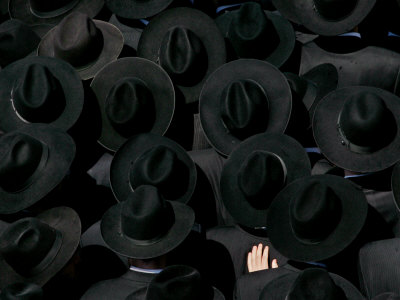What is Halakhic Minimalism? And why should you care about it?
With the concept of Halakhic Minimalism, we make a few base assumptions.- The Jewish people are at their best when following Halakha.
- The more Jews following Halakha the better.
- Not every Jew in every place needs to behave in the exact same way. I.e There is no one true way to follow halakha.
- Every Chumra is a Kulah, and every Kulah is a Chumra. ("I'm not being meikil about eating on Yom Kippur I’m being machmir about pikuach nefesh." )
Since the destruction of the first beit Hamikdash, there were less Jews in Israel than in any other country
or land in the world. Today however, the opposite is true. Because of our long exile, what this means is
that in Israel today, we have the largest collection of minhagim and interpretations of halacha all living
side by side together. The country, and the Jewish people in general, are divided among themselves.
In some places, this diversity of halachic thought creates a unique atmosphere, where members of the
community interact with one another, and most of the time, their differences are forgotten or ignored.
However, in most places, this is not the case. Instead, we divide ourselves up by one identifying feature
or another, and see most other Jews only as Kiruv opportunities for our own way of following Halakah.
The Goal of Halakhic minimalism then, is to give us all the tools, to create the ‘unique atmosphere’ that
in an ideal Jewish world, would not be unique at all. In those few and far between communities, where
Jews of all halakhic ways of life, are able to commingle, they are already practicing Halakhic minimalism.
So what exactly is Halakic Minimalism? The term is not yet well defined, as only the Jewish people as a
whole will be able to properly define it, but, if forced, which I am, I would define it as this:
For every issue in Halakkah, there is a minimum requirement, a minimum cost, or a minimum impact on others. The job of the community is to enforce those minimums, accept those minimums, but also allow for others to expand upon them, as they desire for themselves.
Before, getting into an example of how we might apply Halakhic minimalism today (I hope to do that in
a future post about Kashrut), let’s look at how we know what the Halkhic minimum is. The best way to
learn what the Halakhic minimum is, is to look at what the Halakhic minimum is not.
Kaaraites:
The Kaarite Jewish community is famously known for taking a certain type of Minimalism. They profess
to follow only the written Torah. It would seem, that Kaarites, then hold of a Halakhic minimalism,
in which the Torah is the minimum framework with which they work with. However, a quick look at
Kaarite Judaism, will show that this is not the case. As we know, the Torah cannot be fully understood,
or followed on a practical basis without some sort of Oral Tradition. The Kaarites, then, are not Torah
minimalist, but rather offer an alternative “oral tradition”, and they have their own internal disputes as
well. We can learn from the Kaarite community, that a Halakhic Minium is not based on the Torah, or
Tanakh alone. The Oral Law is required as well.
Reform Judaism:
The Reform Jewish community, is also famous for taking a certain type of Minimalism. In the Reform
platform, those halakhot which a person finds meaningful, or which are clearly aimed at improving
one’s moral character, or increasing justice in the world, are used as guidelines on how a Jew should
act. Those which a person does not gain meaning from, can be ignored. There are two problems with
this. One which is obvious to the Orthodox community, is that it removes the entire concept of Halakah.
You can’t have Halakhic minimalism, if you don’t even have Halakha, some basis is required. The other
problem is more subtle, and also more important. The past few hundred years, has shown us, that the
Jewish community as a whole just cannot tolerate this level of Halakha abandonment. Having a group
which accepts the Oral Tradition, but rejects the binding nature of even the most minimal components
of Halakha, splits the Jewish people in a way that cannot be easily mended. Reform Judaism teaches us
that a Minimal standard is required.
So if we know that a minimum standard is required, and we know that the Oral traditions are required,
what is the minimal approach to Halakha?
Shulchan Aruch Judaism:
I can hear some of you asking, “Shulcchan Aruch Judaism?? What the hell is that? Don’t you mean
Orthodox Judaism?” So, yes, and no. Since the Rambam wrote the Mishneh Torah, Halakhic Jews have
been trying to take the contents of the Misha, Tosefta, Talmud Yerushalmi, Talmud Bavli , Sifri, etc. and
put them into an organized, easy to read, easy to remember, code of Halakah law. If you want to know
what to do, you can look it up in the codex. These codexes have worked very well for the past centuries
for the Jewish communities they were written for. The Yeminites followed the Rambam, some groups in
Spain and Egypt followed the Rambam. Groups from northern and eastern Europe followed the Ramah,
those in the Middle East headed the words of R. Yosef Kairo. Chasidic groups have their own books of
law as well, such as the Shulchan Aruch Harav. As the Jewish people moved around, customs mixed,
and communities rose and fell, new code books were required, such as the Mishneh Berura. It is interesting to note, that in many of these new books since the Shulchan Aruch, the process of 'best 2 out of 3' seems to be the norm. I refer to all of these different code books when I say “Shulchan Aruch Judaism”. The biggest common factor between all these books, is that they record what the customs and traditions of their communities were.
Starting with the Shulchan Aruch, I would call these ways of codifying halacha as “Halakhic Maximalism”.
The shift of the Shulchan Aruch was the process of taking the best “2 out of 3” for any halakhic issue,
except for cases where the Ari’s understanding of the Zohar could be applied. This codification of
halakha has taken the Jewish people down a path that at one time made sense, but today, with the
complete mixing of the people, now seems to cause more harm than good. While once, Halakha was
decided by looking into the Talmud, and applying the principles to the situations of the day, now the
Talmud is learned only l’shma, and not for any practical purpose. Since the age of codification of Halkah,
the Jewish people have declined in observance of Halakhah. While 500 years ago, perhaps 80% of the
Jewish people felt bound to Halakah today, less than 20% do. What we can learn from Shulchan Aruch
Judaism, is that Halalkhic Maximimalism, or a one size fits all mentality, leads to less Jews on whom
Halakha fits at all.**
This is not the first time this has happened in Jewish History. In the Book of Kings 1, chapter 12 verse 4, the leader of the Northern Kingdom of Israel, says to King Solomon's son, "Your father put a heavy yoke on us, but now lighten the harsh labor and the heavy yoke he put on us, and we will serve you." The result of this request, was a "doubling down", and making the yoke even more harsh, causing the the Northern Kingdom of Israel, to reject Jerusalem, the line of David, and to put up idols directed towards no god in particular, and to make Cohanim out of any tribe in Israel. The Prophets tell us that in the future, they will return to a united Israel. But if we act like Rehoboam, that will never happen.
Taking these three lessons together, we can define Halakahic minimalism.
- Halakha must be based on the Written and Oral Torah.
- The Minimal Halakhaic position, must not be so minimal as to be non-existent. It cannot survive as a pick and choose system. Rather, we will recognize the minimal requirements, even when in practice, we would rather go far beyond them.
- The Halakha must be clearly sourced in the Torah, Tanakh, Mishna, Talmud Yerushalmi, Talmud Bavli, Sifri or Tosephta.
- We must try our best to include as many people’s practices into halakah rather than exclude.
- We must acknowledge the flexibility of halakhah, where it exists, (No amount of flexibility will allow us to eat a natural pig, or start a fire on Shabbat) within our own communities, not just in reference to some “other” community, that we don’t “hold by”.
** You can read an interesting analysis of Halackha here: http://mosaicmagazine.com/essay/2013/12/what-is-this-thing-called-law/ and a response here:
http://torahmusings.com/2013/12/the-art-of-halakhah/


